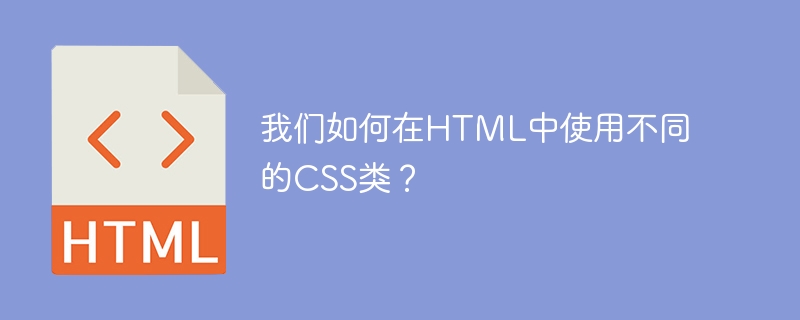我們如何在HTML中使用不同的CSS類別?

我們使用class屬性來為HTML元素指定一個類別。
多個 HTML 元素可以共用同一個類別。使用類別的各種屬性,例如更改顏色、字體等,我們可以為這些 HTML 元素定義樣式規則。具有該類別的元素將根據定義的規則進行格式化。這稱為類別選擇器。
要選擇具有特定類別的元素,您需要編寫一個句點(.)字符,後面跟上類別的名稱,例如,讓我們看一下“.black”類,
.black {
color: #000000;
}
對於我們文件中class屬性設定為black的每個元素,以黑色渲染內容。例如,僅對class屬性設定為black的
元素以黑色渲染內容。
h3.black {
color: #000000;
}
登入後複製
h3.black {
color: #000000;
}
我們使用類別屬性來指向樣式表中的類別名稱。 JavaScript 也可以使用它來存取具有特定類別名稱的元素。
範例 1
下面給出了一個範例,其中我們有兩個 元素,它們的 class 屬性具有相同的值。所有 元素將根據 head 標記中的樣式定義進行相同的樣式設定。
<!DOCTYPE html>
<html>
<head>
<meta charset="UTF-8">
<meta name="description" content="meta tag in the web document">
<meta name="keywords" content="HTML,CSS">
<meta name="author" content="lokesh">
<meta name="viewport" content="width=device-width, initial-scale=1.0">
<style>
.information,ol {
border: 2px solid black;
margin: 20px;
padding: 20px;
}
ol{
background-color: darkgoldenrod;
}
</style>
</head>
<body>
<div class="information">
<h2 id="Jason">Jason</h2>
<ol>
<li>Bachelor's of Engineering</li>
<li>IT stream</li>
<li>section -A</li>
</ol>
</div>
<div class="information">
<h2 id="Abdul">Abdul</h2>
<ol>
<li>Bachelor's of Engineering</li>
<li>IT stream</li>
<li>section -B</li>
</ol>
</div>
</body>
</html>
以下是上述範例程式的輸出。
Example 2
的中文翻譯為:範例2
下面給出了一個範例,其中我們有兩個 元素,它們的 class 屬性具有不同的值。兩個 元素將根據 head 標記中的樣式定義設定樣式。
要定義多個類,請用空格分隔類名。元素將根據指定的類別進行樣式設定。
<!DOCTYPE html>
<html>
<head>
<meta charset="UTF-8">
<meta name="description" content="meta tag in the web document">
<meta name="keywords" content="HTML,CSS">
<meta name="author" content="lokesh">
<meta name="viewport" content="width=device-width, initial-scale=1.0">
<style>
.room {
font-family: monospace;
font-size: 200%;
color: tomato;
text-align: center;
}
.two{
font-family: cursive;
color: lawngreen;
text-align: center;
}
</style>
</head>
<body>
<p class="room">Meta tag contents are not visible on your browser.</p>
<p class="room two"> The mata tag is added inside the head tag.</p>
</body>
</html>
要定義多個類,請用空格分隔類名或指定不同的值。元素將根據指定的類別進行樣式設定。
Example 3
的中文翻譯為:範例 3
給出以下範例,其中我們有三個具有不同值的class屬性的元素。根據head標籤中的樣式定義,兩個元素將被等同地進行樣式設置,而另一個元素將根據head標籤中的樣式定義進行樣式設置<!DOCTYPE html>
<html>
<head>
<meta charset="UTF-8">
<meta name="description" content="meta tag in the web document">
<meta name="keywords" content="HTML,CSS">
<meta name="author" content="lokesh">
<meta name="viewport" content="width=device-width, initial-scale=1.0">
<style>
.information,ol {
border: 2px solid black;
margin: 20px;
padding: 20px;
}
.computerscience,ul {
border: 2px solid black;
margin: 20px;
padding: 20px;
}
ol{
background-color: brown;
}
ul{
background-color: tomato;
}
</style>
</head>
<body>
<div class="information">
<h2 id="Jason">Jason</h2>
<ol>
<li>Bachelor's of Engineering</li>
<li>IT stream</li>
<li>section -A</li>
</ol>
</div>
<div class="information">
<h2 id="Abdul">Abdul</h2>
<ol>
<li>Bachelor's of Engineering</li>
<li>IT stream</li>
<li>section -B</li>
</ol>
</div>
<div class="computerscience">
<h2 id="Satya">Satya</h2>
<ul>
<li>Bachelor's of Engineering</li>
<li>Cse stream</li>
<li>section -A</li>
</ul>
</div>
</body>
</html>
以下是上述範例程式的輸出。
Example 4
的中文翻譯為:範例 4
另一個例子可以包含對
標籤進行樣式設定。透過以下方式,將所有具有class="device"的
元素進行樣式設定
<!DOCTYPE html>
<html>
<head>
<style>
p.device {
background: #000000;
color: #fffffF;
}
</style>
</head>
<body>
<p>This is demo text</p>
<p class="device">Information about devices.</p>
<p>This is demo text</p>
</body>
</html>
範例 5
標籤的樣式可以透過多個類別來完成,即此處的裝置和配件 -
<!DOCTYPE html>
<html>
<head>
<style>
p.device {
background: #000000;
color: #fffffF;
}
p.accessories {
text-align: center;
}
</style>
</head>
<body>
<p class="device accessories">DEVICE DETAILS</p>
<p class="device">Information about devices.</p>
</body>
</html>
以上是我們如何在HTML中使用不同的CSS類別?的詳細內容。更多資訊請關注PHP中文網其他相關文章!

熱AI工具

Undresser.AI Undress
人工智慧驅動的應用程序,用於創建逼真的裸體照片

AI Clothes Remover
用於從照片中去除衣服的線上人工智慧工具。

Undress AI Tool
免費脫衣圖片

Clothoff.io
AI脫衣器

AI Hentai Generator
免費產生 AI 無盡。

熱門文章

熱工具

記事本++7.3.1
好用且免費的程式碼編輯器

SublimeText3漢化版
中文版,非常好用

禪工作室 13.0.1
強大的PHP整合開發環境

Dreamweaver CS6
視覺化網頁開發工具

SublimeText3 Mac版
神級程式碼編輯軟體(SublimeText3)

熱門話題
 &gt; gt;的目的是什麼 元素?
Mar 21, 2025 pm 12:34 PM
&gt; gt;的目的是什麼 元素?
Mar 21, 2025 pm 12:34 PM
本文討論了HTML&lt; Progress&gt;元素,其目的,樣式和與&lt; meter&gt;元素。主要重點是使用&lt; progress&gt;為了完成任務和LT;儀表&gt;對於stati
 &lt; datalist&gt;的目的是什麼。 元素?
Mar 21, 2025 pm 12:33 PM
&lt; datalist&gt;的目的是什麼。 元素?
Mar 21, 2025 pm 12:33 PM
本文討論了html&lt; datalist&gt;元素,通過提供自動完整建議,改善用戶體驗並減少錯誤來增強表格。Character計數:159
 &lt; meter&gt;的目的是什麼。 元素?
Mar 21, 2025 pm 12:35 PM
&lt; meter&gt;的目的是什麼。 元素?
Mar 21, 2025 pm 12:35 PM
本文討論了HTML&lt; meter&gt;元素,用於在一個範圍內顯示標量或分數值及其在Web開發中的常見應用。它區分了&lt; meter&gt;從&lt; progress&gt;和前
 如何使用HTML5表單驗證屬性來驗證用戶輸入?
Mar 17, 2025 pm 12:27 PM
如何使用HTML5表單驗證屬性來驗證用戶輸入?
Mar 17, 2025 pm 12:27 PM
本文討論了使用HTML5表單驗證屬性,例如必需的,圖案,最小,最大和長度限制,以直接在瀏覽器中驗證用戶輸入。
 視口元標籤是什麼?為什麼對響應式設計很重要?
Mar 20, 2025 pm 05:56 PM
視口元標籤是什麼?為什麼對響應式設計很重要?
Mar 20, 2025 pm 05:56 PM
本文討論了視口元標籤,這對於移動設備上的響應式Web設計至關重要。它解釋瞭如何正確使用確保最佳的內容縮放和用戶交互,而濫用可能會導致設計和可訪問性問題。
 &lt; iframe&gt;的目的是什麼。 標籤?使用時的安全考慮是什麼?
Mar 20, 2025 pm 06:05 PM
&lt; iframe&gt;的目的是什麼。 標籤?使用時的安全考慮是什麼?
Mar 20, 2025 pm 06:05 PM
本文討論了&lt; iframe&gt;將外部內容嵌入網頁,其常見用途,安全風險以及諸如對象標籤和API等替代方案的目的。
 Gitee Pages靜態網站部署失敗:單個文件404錯誤如何排查和解決?
Apr 04, 2025 pm 11:54 PM
Gitee Pages靜態網站部署失敗:單個文件404錯誤如何排查和解決?
Apr 04, 2025 pm 11:54 PM
GiteePages靜態網站部署失敗:404錯誤排查與解決在使用Gitee...







